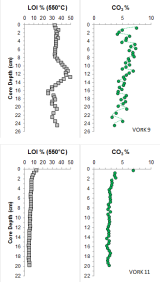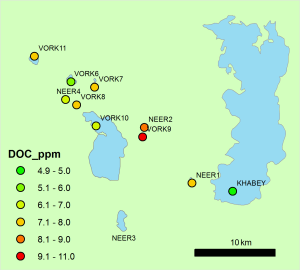International Scientific Cooperation
Lakes and carbon
Dr Viv Jones, Dr Nadia Solovieva, Dr Simon Turner (University College London, UK) along with Dr Olga Loskutova from the Komi Science Centre are investigating the role of lakes in the
carbon cycle. They have been working in the Lake Setti area (67°33'N, 62°34'E) of the Bol'shezemel'skaya Tundra 50km E of Vorkuta, an area, which is rich in lakes. Lakes play an important role in the terrestrial carbon cycle, mineralizing terrestrially-fixed C as well as burying large amounts in their sediments. Most arctic lakes are assumed to be net heterotrophic, i.e. net ecosystem respiration is greater than ecosystem primary production. This metabolic balance requires an external C source: usually dissolved organic carbon (DOC) derived from catchment soils. The mineralization of terrestrially-derived DOC results in the release of large amounts of CO2 from lakes. Not all Arctic lakes behave in this fashion, and many lakes are net autotrophic and therefore C-sinks.
As the Arctic warms, relationships between lakes and their catchments will change. Thermokarst lakes show rapid areal and depth changes linked to ground-ice subsidence, while the enhanced erosion of shorelines and feeder streams can substantially increase the carbon load, all of which result in high CH4 emissions. The deepening of the annual active soil layer increases the C transfer to lakes, which supports more microbial mineralization and hence CO2 release. However, deepening thaw also transfers nutrients (N, P), and, as most arctic lakes are nutrient limited, this increased nutrient load may enhance in-lake primary productivity. The impact on net C flux of a shifting balance between catchment DOC, mineralization and nutrient loading on C-flux vs C-burial rates has not been considered explicitly. Carbon burial rates in arctic lakes are generally ignored in regional C budgets but can be up to 10–15 g m–2 yr–1, a significant amount when compared to emission rates
 To do this we cored 12 lakes and we will use 210Pb-dating to provide a chronology for the past 150 years. The cores were sectioned in the field at 0.5 cm intervals, and processed for organic and carbonate content, measured by combustion). As sediment accumulates non-uniformly in lake basins we will use the 210Pb flux correction method to derive whole basin average C burial rates.
To do this we cored 12 lakes and we will use 210Pb-dating to provide a chronology for the past 150 years. The cores were sectioned in the field at 0.5 cm intervals, and processed for organic and carbonate content, measured by combustion). As sediment accumulates non-uniformly in lake basins we will use the 210Pb flux correction method to derive whole basin average C burial rates.
Preliminary results show that there are considerable local differences between lakes in terms of burial of organic matter in recent sediments (left).
In VORK 9 we can see that there has been a past phase of increased organic carbon accumulation (50% LOI 550°C = ~ 0.25g C g-1 driedsediment). This looks to have been due to an increase in plant matter burial, perhaps caused by a drop in lake level.
In VORK11 organic carbon has not been preserved in the recent lake sediments. Low carbon burial rates indicate low lake water productivity, low rates of sediment accumulation and high rates of decomposition/recycling of C between lake water and sediments. The majority of the lake sequences investigated had LOI 550°C values less than 15% like VORK11.

Preliminary analysis of phytoplankton in Neer1, Neer2 and Vork 7 showed total dominance of Anabaena flos-aquae, indicating possible summer eutrophication of these lakes.




